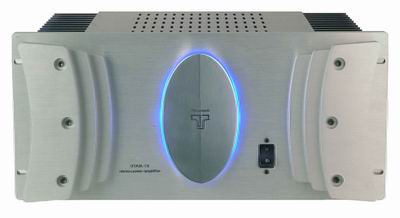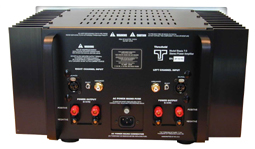Threshold STASIS 7.0 Amplifier
| Threshold STASIS 7.0 Amplifier |
|
|
|
Marshall Nack |
|
20 September 2002 |
 Specifications
Specifications
Balanced or single ended operation
Nominal Power Output (20Hz-20kHz)
100 Watts per channel at 8 Ohms
200 Watts per channel at 4 Ohms
Maximum Output Current: +/- 20 Amps
Frequency Response: DC- 50kHz
Distortion: 0.02% at 1kHz, at rated output power
Voltage Gain: 28 dB
Input Impedance: 22k ohm (RCA), 600 ohm (XLR)
Input Sensitivity: 1.12V RMS for full power output
Output Impedance: less than 0.05 ohm from 20Hz-20kHz  Damping Factor: greater than 160 for 8 ohm load, 20Hz-20kHz, at 1 Watt
Damping Factor: greater than 160 for 8 ohm load, 20Hz-20kHz, at 1 Watt
Dimensions: 19” W × 9.3” H ×15.8” D
Weight: 64 lbs., 29 kg.
Serial number of unit: 207259
Price: $7000
Address:
Threshold Audio, Inc.
P. O. Box 41736
Houston, Texas 77241
U.S.A.
Phone: 713.466.1411
Fax: 713.856.0278
Web: www.threshold-audio.com/
Sales Department: sales@threshold-audio.com
Service & Support: support@threshold-audio.com
Threshold is a company with a long history in pro audio and the high-end market. Founded in 1974 by Nelson Pass, the company made a name for itself with a series of products using its patented STASIS technology. In the late 1980’s, Pass retired. The company enjoyed nearly a decade of success after Nelson Pass’s departure with their highly acclaimed T-series preamps and power amps. Then in the late 1990’s times changed, the company faltered and suspended operations. In 2000, Threshold re-emerged as Threshold Audio with a product group featuring an updated version of STASIS output design.
As the Threshold promo sheet for the STASIS 7.0 amp says, “Its outer appearance may suggests an obsession with solidity and power.” The polished silver anodized aluminum front panel is enhanced with a large, bright blue power on indicator. This blue mood light is buttressed on both sides with layered aluminum slabs. Think of the Michelin man. But it’s not just the amp’s appearance that suggests power.
I’ve been playing a game with visitors. I sit them down in the sweet spot and play a tune for them, usually Henry Purcell’s Odes a Sainte Cecile [harmonia mundi HMC901643]. Only when track one is over do I say, “Now I’ll turn on the sub-woofer.” To which they respond, “I’ve never heard bass like that from your EgglestonWorks ROSAs before.” And they’re not kidding.
Except for the faceplate, the chassis is the usual black metal, with heat sinks along the sides. This is a balanced design, but both balanced and single ended gold plated inputs are provided. You choose between input modes via a toggle switch. Two sets of gold plated speaker binding posts make for easy biwiring. A pair of sturdy handles on the back came in very handy for easy carrying.
What’s under the hood is all sorts of premium stuff: military-spec precision resistors, military-grade glass-epoxy circuit boards, computer-grade capacitors, close tolerance hand matched JFETS, and a custom 12 lb. toroidal power transformer. The design features high-current, high-bias design, balanced operation and direct-coupled input to output with no capacitors in the signal path. Minimal feedback is employed. The STASIS runs hot and it is recommended that you leave it on all the time. Allow plenty of ventilation room; say 4″ on each end and on top. From power off it requires about an hour to come to thermal stability.
After 60 hours the amp began to loosen up. At 100 hours it had more micro dynamics and subtlety, and I heard most of its true character. The manufacturer claims it will continue to improve for up to 300 hours.
It Lives On The Dark Side
My initial impression turned out to be my lasting assessment. As advertised, the Stasis 7.0 is one hell of a forceful, dynamic brute. Its most prominent feature is a powerful and articulate low end. Instruments that live in the low registers acquired more musical life and importance. If bass or orchestral heft is your thing, you’re in for a treat. The midrange and treble are slightly warm and sweet, but basically neutral. The treble is a little soft – it could use more extension and nuance. This combination of low-end slam, neutral midrange and a slightly soft treble can make for some seductive listening. The presentation is full bodied without being fat in the bottom or strident on top. While some amps have frequency related colorations, causing disturbing discontinuities, there is little “editorializing” here. The sound quality across the frequency spectrum is cut from the same cloth.
First up was Handel’s Marian Cantatas and Arias [DG D105958], featuring mezzo soprano Anne Sofie Von Otter and Musica Antiqua Köln. This is one terrific combination. Anne Sofie is stylistically perfect for baroque cantatas, and Musica Antiqua Koln, with its eccentric leader Reinhard Goebel, sets the pace for period instrument performance. Track one, “Haec est Regina virginum” gets top marks for both recording and performance, and it was included on one of the Burmester samplers. There are many other good tracks on this CD. The scoring, which includes an organ underpinning, benefits from the power of the Threshold. You get a feeling that there’s power in reserve, even as it dishes up waves of organ pedal notes. The organ’s extra weight splendidly counterpoints Anne Sofie’s warm and grainless vocals. There’s no sense of strain or breakup as she ascends towards the heavens. Dynamics were continuous, smoothly progressing up and down, not like the discrete jumps of a ratchet mechanism. This amp is easy to listen to. I didn’t find myself getting up every few minutes to tweak away at some perceived problem. In many ways, the STASIS reminded me of my reference tube amps, but with a dose of steroids.
On AFTER MOZART [Nonesuch 79633-2], with Gidon Kremer and his Kremerata Baltica, there is a near perfect mix of close-up detail from the spot mikes and ambient cues from the recording location. You can enjoy the sound of individual instruments or shift focus to the reverberant sound of the church. The program consists of authentic Mozart pieces alternating with contemporary composers using his motifs for new works. This is an old formula that works well here. This group of young players is able to put over contemporary eastern European compositions. Their Mozart, on the other hand, is a little quirky, stressing the offbeat, or the like. The sound of the strings is good. The STASIS provides that extra punch, lending a dance-like quality to the “Serenata Notturna.” Also, the noise had dropped, and allowed marginal details to become audible.
Soundstaging is as good as it gets in my room – wide and deep with excellent instrument separation, image stability and front to back layering. The presentation is slightly forward.
Listen to track one, “Minor Blue” from Dance of the Night Creatures[Mapleshade MS 06032]. The opening duet featuring Thurman Green on trombone and Hamiet Bluiett on baritone sax is in some complicated, undecipherable (to me) time signature. Yet it contains an ingratiating melody. The soloists wend and weave around this tune, Bluiett typically unpredictable, Green more reserved and straight-ahead. After a statement of the theme, the rhythm section of bass, drums and piano makes a quiet entrance, gathering strength as the music unfolds. Again, the extra propulsive forces provided by the Threshold notched up the “jump” factor. Initial transients had more snap. Dynamic swings had more power and authority. Jazz in general benefits from increases in these qualities and the Threshold delivered them in spades.
Finally, Some AC Conditioning
The minor complaints I had about the STASIS 7.0 arose in comparison to my reference tube amps. The sound was a little tight, a little lacking in nuance and air. This was mainly due to the treble, which, while smooth, controlled and without stridency, didn’t extend to the stratosphere.
When I tried the STASIS with my Accuphase PS-500 AC conditioner, which is rated to handle up to 500 watts, the Accuphase overloaded. The STASIS, while rated at 100 watts/channel, is a high current design, so the wattage rating is deceptive. It requires more current than the Accuphase can deliver.
With the Legend Audio Design Live Performance AC conditioner and a Legend power cord in place of the Harmonic Technology Magic power cord going straight into the wall, the good qualities I hinted at above came to the fore. Also, the minor complaints listed above were all diminished. On Dance of the Night Creatures, little events began to make themselves known, like the small noises from the keys on the Bari sax flapping around. The double bass took on a more rounded, complex character. The piano became more resonant and more like a Steinway should sound. Cymbals made more realistic SSSH sounds. It was wonderful how the drum kit took over the real estate in the right corner. The sound of this CD is reference caliber. Once again Mapleshade engineering distinguished itself as the top of the class. This was all made eminently evident with the STASIS connected to the Legend AC conditioner, which stayed in for the remainder of the STASIS review. Classical music benefited similarly. Gone also was the slight wiry character of orchestral strings.
Wires And Accessories
Substituting the new Shunyata Taipan for the Legend power cord lifted the treble ceiling, gave a taught, punchy bass, but raised the overall timbral balance into the treble. Both were very musical; choose the one that works best for you.
Conclusion
Smooth, almost tube-like in the lack of edge and grain, the STASIS 7.0 had a fair amount of the bloom and warmth of my reference tube amps. Combine this with a level of slam and dynamics that you won’t get from tubes and you have a happy marriage of the virtues of both technologies. The STASIS 7.0 can play all kinds of music, and is especially suitable for jazz. An AC conditioner with high current capability is mandatory. Visually, this is not your usual self-effacing black box. The art deco faceplate and the large blue indicator light make a definite design statement. Some visitors dug its looks; other didn’t care for it. Lastly is the matter of its $7000 list price. If it were less expensive, the STASIS 7.0 would be a category killer. At this price, it joins the select group of class A solid state amps.
![]()
Don’t forget to bookmark us! (CTRL-SHFT-D)
Stereo Times Masthead
Publisher/Founder
Clement Perry
Editor
Dave Thomas
Senior Editors
Frank Alles, Mike Girardi, Russell Lichter, Terry London, Moreno Mitchell, Paul Szabady, Bill Wells, Mike Wright, and Stephen Yan,
Current Contributors
David Abramson, Tim Barrall, Dave Allison, Ron Cook, Lewis Dardick, John Hoffman, Dan Secula, Don Shaulis, Greg Simmons, Eric Teh, Greg Voth, Richard Willie, Ed Van Winkle, Rob Dockery, Richard Doran, and Daveed Turek
Site Management Clement Perry
Ad Designer: Martin Perry





Be the first to comment on: Threshold STASIS 7.0 Amplifier